5 Different Types of Paint Sprayers: Which is Right for You?
-

- Last updated:


Paint sprayers can be used to cover single objects, full walls, or entire rooms with your choice of paint. They provide more uniform coverage than brushes and rollers and do not have brush marks or other marks from the painting process. There are five types of paint sprayers on the market, but the most commonly used are the airless paint sprayer, electric paint sprayer, and compressed air or pneumatic paint sprayer. The ideal sprayer depends on your level of expertise, how much coverage you require, the level of detail needed, and your budget.
The 5 Different Types of Paint Sprayers
Below, we’ve included details of the five main variants of paint sprayers, including details of the most common uses for each type and their pros and cons. Using this information, you should be able to determine the best spray gun for your project.
1. Airless Paint Sprayer
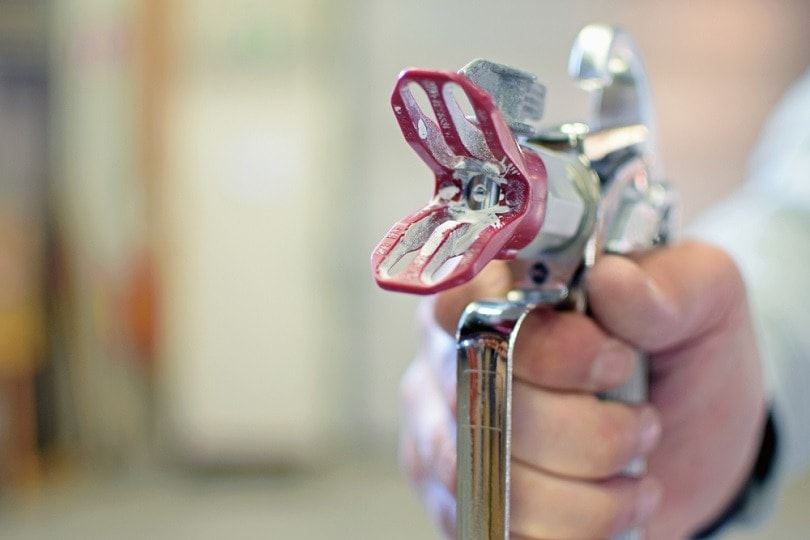
The airless paint sprayer does not use compressed air. Instead, it uses an electric pump to propel the paint through the sprayer’s tip, which causes a fan or arc of paint. The paint sticks to the surface and leaves a smooth finish. The electric spray gun takes little preparation and is ready to use immediately.
It will cover a large area in a short time, and while this means that it is the most useful model for finishing walls or entire properties, it also takes practice to get your speed up. If you work too slowly, the fast jet of the airless paint sprayer will continue to apply coat after coat on the same spot. This is called overspray, and it can leave you with non-uniform coverage of a wall while also using more paint.
- Volume work
- Professional contractor work
- Lacquering and varnishing paint
The rapid spraying of an airless model is used for mass coverage. If you paint an entire room or multiple walls in a home, an airless paint sprayer is a good choice. If you are a professional handyman or contractor, the speed of this device is also beneficial. However, besides providing more coverage, the electric spray gun may not be your best option.
It does not work well outdoors, but that is true of any type of paint sprayer. The potential for overspray also means it is unsuitable for precision work. If you are looking for a reliable way to spray furniture, you are unlikely to get the desired results from an airless sprayer.
Are Electric Paint Spray Guns Any Good?
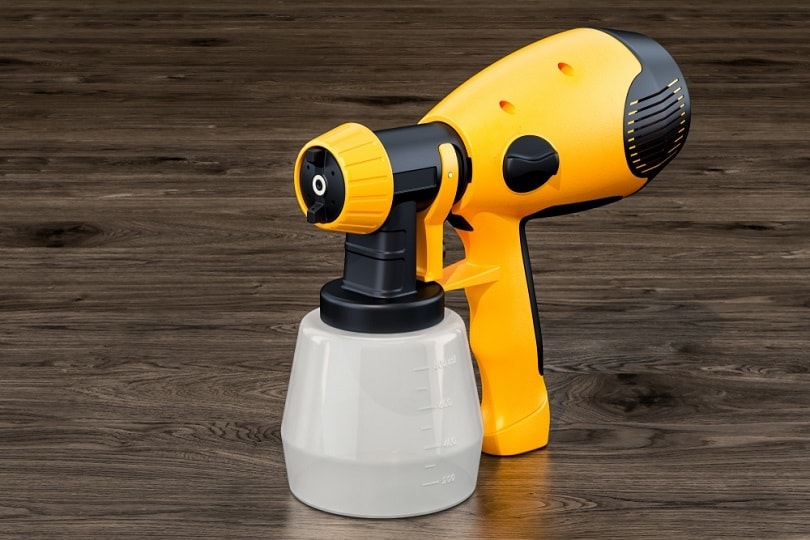
Electric paint spray guns are highly efficient. They may be too efficient for the uninitiated and the inexperienced. The paint stream does not contain any air bubbles, which means that a large volume of paint is applied directly to the surface you’re working on. If you can keep up with the speed of the jet, it provides the fastest spray-painting solution for volume work. It isn’t suitable for precision work, however.
- If you are experienced using an airless spray gun, you can look for the device with the highest horsepower that delivers the most paint in the shortest time. This will enable you to finish projects quickly.
- Ensure that the gun includes the tip you need for your project.
- Also, consider the hose length. If you spray a fence, you need a long hose because that will negate having to keep stopping to move the spray unit.
- If you’re painting rooms, you should be able to keep the unit in a single position and reach all of the walls.
- Some electric spray guns may accept more than one gun, allowing multiple people to work on a project simultaneously.
- Uniform coverage
- Fast paint delivery
- Works with different stains and paints
- Wastes paint
- Not a clean process
- Not suitable for precision work
- Can be expensive
2. HVLP

The HVLP, or High-Volume, Low-Pressure paint sprayer, is more of a precision unit. As the name suggests, it operates with a lower pressure, which means that less paint is ejected from the tip at any time. It is also mixed with the air molecules used to pressurize the paint. Therefore, the HVLP sprayer is easier to control, causes less of a mess, and can be used for precision work.
It’s ideal for painting crown molding or detailed work on a carpentry job. However, the low pressure makes it only suitable for thinner paints, and even when used with thinner liquids, it may still become clogged and require regular cleaning.
- Painting trims and molds
- Finishing furniture and other projects
- Cabinets and doors
An HVLP may not be suitable for volume work and will take a long time to paint a room. What’s more, the low pressure necessitates a short hose, so the device must be carried or moved frequently, making it an uncomfortable and inconvenient tool because of the potential for user fatigue.
Where the HVLP excels, however, is in its precision work. Paint is delivered slowly and precisely, so if you want to ensure that you get even coverage of a specific area, this is the spray gun for you. If you can use a thin enough lacquer or paint, it can also be used for painting furniture and other craft projects.
Is Airless or HVLP Better?
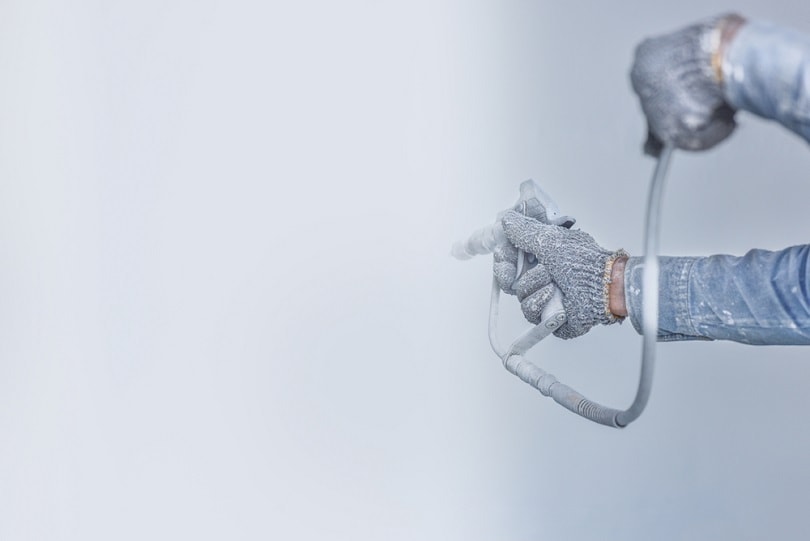
- The airless spray gun delivers a large volume of airless paint and is better suited to volume work where precision is not required. It is better suited for experienced professionals.
- The HVLP delivers less paint, makes less mess, and has less cleanup. It is better suited to precision work and can be too inconvenient for big jobs.
- Costs less than an airless sprayer
- Used for precise finishes
- Safer than airless
- Clogs often
- Can cause user fatigue
- Unsuitable for big jobs
- Unsuitable for thick paints
3. LVLP
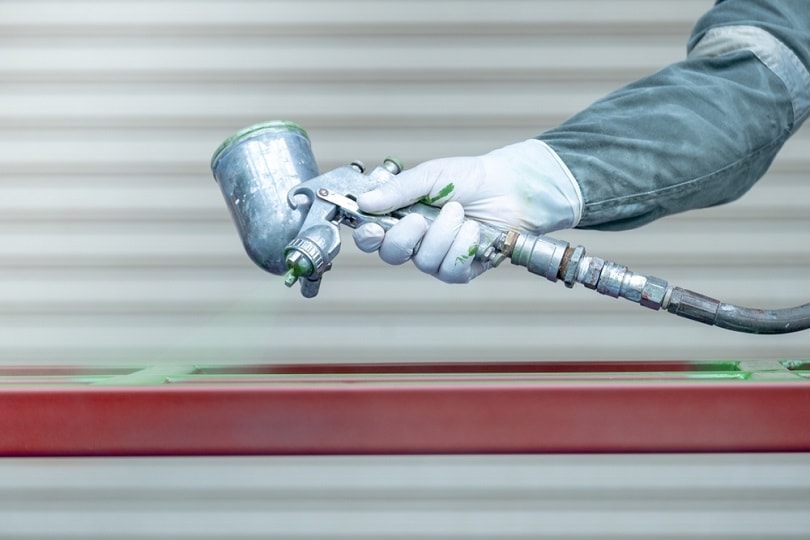
LVLP stands for Low-Volume, Low-Pressure, and the devices only require around 10PSI to operate. This makes them suitable for use by the DIYer because they can use basic air compressors that are available for a fraction of the cost of those required for other compressed air devices.
They are also much smaller than other devices, and their design allows you to carry the entire unit, including the paint tank or reservoir, as you use it. The spray must emit a low-volume load to ensure it is portable and can be carried.
- Painting interior walls
- Painting fences
Some models may be awkward to carry, but they will work on big projects like spraying a fence or a whole wall. However, the system’s low-pressure spray is not powerful enough to eject thick and viscous liquids, so it only works with thin and light paint.
What Is the Best Type of Paint Sprayer For Home Use?

The LVLP spray painter is the one most commonly used by homeowners. It is inexpensive, easy to operate, and despite being quite heavy after long-term use, it can be used for reasonably large jobs. However, if you intend to use a spray gun to paint every wall in every room of a house, as well as some other jobs like painting the outside of the property, you should consider something more powerful.
- The most affordable option
- Relatively lightweight
- Can be used on large surfaces
- Not suitable for thick paints
- Low volume means regular refills
- Not very powerful or quick
4. Compressed Air
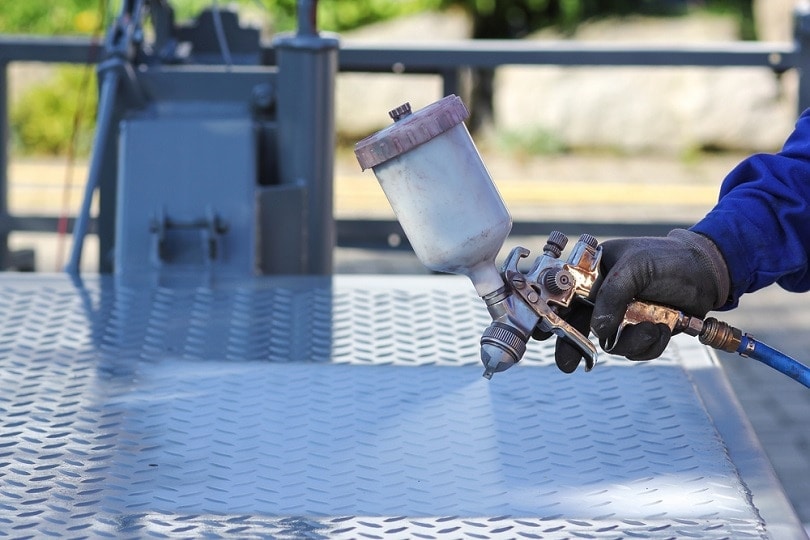
Compressed air sprayers, like the LVLP guns, are easy paint sprayers to use. They use a compressor to create and force compressed air through the paint in the reservoir. This forces the paint down the hose and through the nozzle or tip of the machine.
They are easy to use and less expensive than electric models, but they are gradually being replaced because they do not provide the same uniformity or consistency as an electric unit, and they lack power. You are heavily dependent on the quality and power of your compressor system. However, they do remain popular for artisanal use.
- Painting cabinets and furniture
- On a tight budget
The electric sprayer is gradually replacing the compressed air spray gun. Compressed air units are less powerful, more prone to clogging, and they are not as quick when used to cover large areas. They are used by cabinetmakers, DIYers that make their furniture, and by artists. They are also useful when you already own a compressor system and want a simple but effective solution for painting a large area.
5. Gravity Feed Paint Sprayer
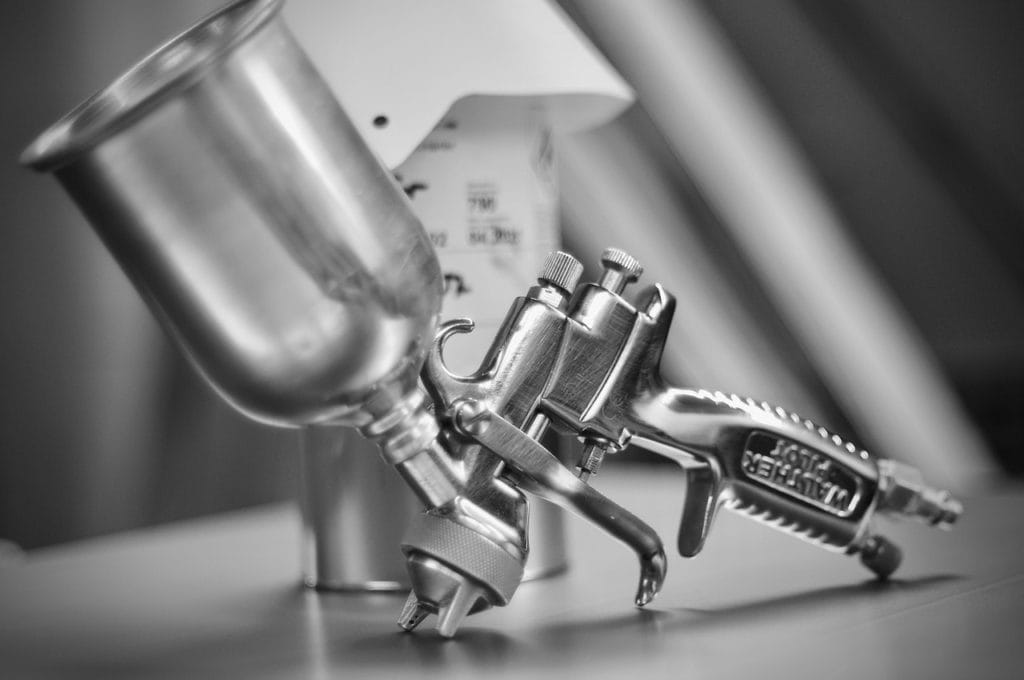
The gravity feed is not a subcategory of paint sprayers but a design element used in various systems. The gravity feed spray gun (so named for the fact that the paint feed reservoir rests atop the sprayer) is another unit designed for producing a fine finish. Much like the HVLP, it can produce various coats on the work surface.
With the siphoning element on the top of the gun, the gravity feed sprayer requires much less pressure than other options. The result is extreme precision, no overspray, and minimal cleanup. This sprayer is often used for spraying cars, which it truly excels at.
You won’t use this approach with larger jobs, but it is an excellent way to add a more refined touch to your work. The gravity sprayer was first employed for automotive work. It’s especially prized for its ability to lay down clear coats of paint. Now, however, it’s used for a wide range of projects.
Works well for: Spraying your car
- Extremely precise
- Easy to clean up
- Not very good for high-volume work
What Is the Easiest Type of Paint Sprayer to Use?
Compressed air paint sprayers are very easy to use. All you have to do is fill the tank with paint, ensure the area is protected, start the compressor, and pull the trigger. Some electric sprayers are not very complicated, but many have dials for pressure levels and other features that make them appear more complicated than they need to be.
- Simple to use
- Cheaper than electric spray guns
- Work with existing air compressors
- Prone to overspray
- May not work with thick paints
- Use a lot of paint
- You might also be interested in: 10 Best Paint Sprayers – Reviews & Top Picks
Conclusion
Various paint sprayers are available, but the most common variant is the electric spray gun. It can cover a large area in a relatively short space of time. Although it may be prone to overspray if you are inexperienced, once you get the hang of using an electric gun, you will be able to get uniform coverage free from brush strokes. However, pneumatic or compressed air sprayers are better for precision and artistic work.
Featured Image Credit: Andrii Anna photographers, Shutterstock
Contents






